#Canonical Tags
Explore tagged Tumblr posts
Text
Fruits Basket Ao3 Media Tags Poll Results, and Some Thoughts on Ao3 Fandom Tag Wrangling
Over the past few weeks, I've put out a few polls to find out how other Ao3 users are using the different Fruits Basket media tags. Here are the results!
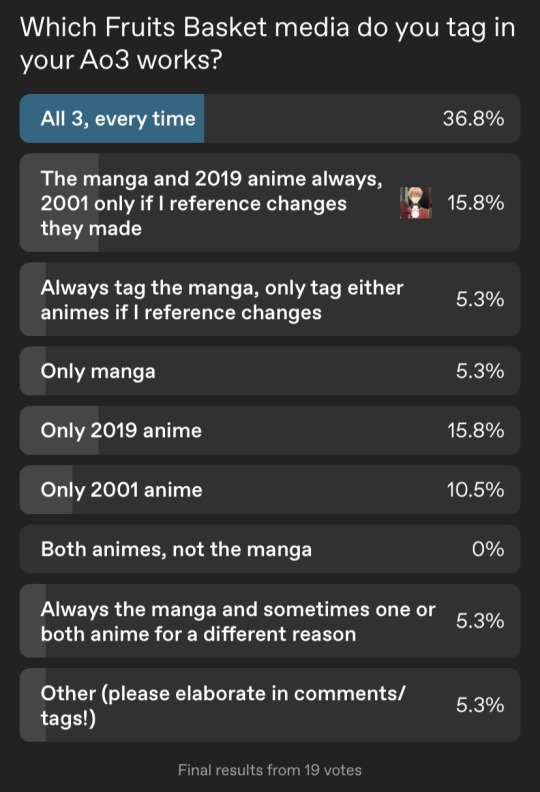
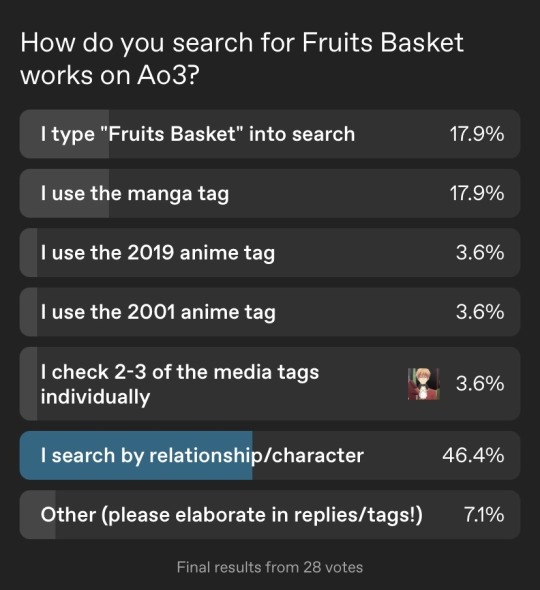

(Obligatory disclaimer that a tumblr poll by one user with fewer than 50 followers is hardly scientific data)
For writers, it looks like most of us (52.6%, or 10 out of 19 respondents) are tagging more than one media type every time, and an additional 10.5% are sometimes tagging multiple media types (total of 63.1%, or 12 out of 19). 31.6%, or 6 out of 19, are only tagging one media type. I believe the person who selected "other" hasn't posted Fruits Basket work yet, but indicated they'd be likely to tag all three.
Of note: even though far more works are tagged with the manga tag than either anime, including when I excluded crossovers, the 2019 anime had the most works updated since January 1 of this year excluding crossovers at 25 (vs 4 for the 2001 anime, and 12 for the manga).
For readers, it looks like most of us (46.4%, or 13 out of 28) are filtering by relationship or character. (Sometimes I think I must be the only person who will read fics for any relationship or character if the premise is interesting!) For those who search using media tags, the manga tag is by far the most used at 17.9%, or 5 out of 28.
Then, 50%, or 14 out of 28 readers don't expect anything different between the three media tags. And that number raises to 78.6%, or 22 out of 28, if you include people who only expect minor differences between content found at each of the three tags.
So, why did I do these polls (and what are my thoughts on how these tags should be wrangled)? More info below the cut!
At some point between when I joined Ao3 and now, the tag "Fruits Basket" went from being a metatag that contained all 3 Fruits Basket media to being made a synonym of the manga.
In practical terms, what this meant for me was that I could no longer sort or filter all Fruits Basket works at once. I would instead have to go to all three media tags separately, and would have to repeat searches for all three media tags if I was looking for a specific trope. Additionally, I didn't actually realize this change until a couple of months after it occurred. I almost missed one of my now-favorite fics because of this change!
Worse still, it means that when I filter out crossovers, any works that are tagged with more than one Fruits Basket media are considered as "crossovers." If I want to filter out actual crossovers, it needs to be done by manually clicking all other fandoms under the "exclude" option.
So, I sent a support ticket to Ao3 asking them to either reverse this change, or add a similar "All Media Types" sort of tag.
They responded after about 12 days, letting me know that the Archive is no longer creating "All Media Types" tags, and is actually dismantling them where possible. The goal is for users to be able to find what they're looking for, and to avoid confusion, which apparently "All Media Types" tags can cause, both for creators and browsing users. They pointed out that searching by relationship or character would allow me to see all works across media tags with those characters (although this doesn't solve my problem).
(Note: no shade to this Ao3 volunteer - I'm not upset at this answer, and they were only communicating Archive policy and were very professional and gave me good and important info!)
Anyway, this confused me, so I sat with it for a bit. I did some searches of the Ao3 blog, the Reddit and Tumblr, and some tag wrangler's Tumblrs where they talk about tag wrangling, but couldn't find anything about dismantling "All Media Types" metatags. So, I decided to get some data. Hence, the polls.
Other than my continued surprise at how many people search by relationship (multishipper problems...), the polls basically aligned with what I expected. So, if I'm using the tags in a similar way to most other users, this can't be the best way for these tags to exist.
I sent a followup request outlining some of what I shared here, then decided to browse Ao3 fandoms outside of Fruits Basket to see how other fandom tags, especially anime/manga fandom tags, were generally canonized.
On the Fandoms page, several "All Media Types" tags are present (Star Wars, Les Mis, Newsies, Batman, and Captain America, to name a few). Additionally, several "& Related Fandoms" tags are also present.
But this might not be a fair comparison. Star Wars has had movies, TV shows, comics, novels, video games, audio novels, radio adaptations, theme park rides, and more. A broad metatag makes sense for that fandom.
Or maybe the Archive just hasn't dismantled those "All Media Types" tags yet?
So, what about other anime and manga? Well, several (including the extremely popular BNHA and Naruto, as well as the shoujo that's always being compared to Furuba, OHSHC) are canonized as (Anime & Manga). Some (like Haikyuu!! and AoT) are canonized so both the manga and the anime are synonyms to the overarching fandom name.
And what about a manga that had two adaptations? Well, Fullmetal Alchemist has an "All Media Types" tag, which acts as a catchall for the 2003 anime, the live action, Bluebird's Illusion (which is apparently a fan-made game?), and a single tag combining the manga and Brotherhood.
So then, I did another search for information on how the Archive is handling "All Media Types" tags.
That search led me to a Tumblr post on tag wrangling guidelines from way back in 2013. Obviously, that post was out of date, but it led me to a handful of other posts, and eventually to the tag wrangling guidelines on the Ao3 website.
I actually didn't know the wrangling guidelines were publicly available before this, so this was exciting! After some brief searching, I was able to find some relevant policies:
Wrangling Guidelines - Metatags still mentioned "All Media Types" metatags in their guidelines, so perhaps those guidelines are out of date? Or instead, they're for those exceptions where "All Media Types" tags make sense?
That page led me to Wrangling Guidelines - Fandoms, which was MUCH more informative.
Under "Base Rules" > "Shared & Similar Names/Multiple Media" > "General Disambiguation Suffixes" it says:
General Disambiguation Suffixes are a legacy disambiguation format and last-resort disambiguation options for fandom tags that could not be easily separated into specific media. Fandoms disambiguated in these ways are no longer being created and are being removed where possible.
General Disambiguation Suffixes includes "All Media Types," "& Related Fandoms," and "Ambiguous Fandom."
Under "Fandoms With Multiple Media" it says:
Existing "All Media Types" tags may have new subtags added beneath them, but should no longer be created. The different existing media tags can be made into subtags under this metatag, as they are added to the Archive. There is no need to make an "All Media Types" metatag just to connect fandoms. Such fandoms can simply sit separately.
Bleh. I guess my hopes have been dashed.
...
But wait!
Under "Anime and Manga" > "Disambiguation Between Manga, Manhwa, Manhua, & Anime" it says:
Anime and manga fandoms should be canonised separately as much as possible. For fandoms where the completed manga and anime canons overlap enough to be considered one unified canon, or the user-made works do not specify whether they are for the anime or the manga, the disambig may be (Anime & Manga), with the terms in alphabetical order.
If canons do not overlap and users make tags for the separate canons, disambiguate with (Anime), (Manga), (Manhwa), or (Manhua).
For this second quote, IT USES FRUITS BASKET AS THE EXAMPLE.
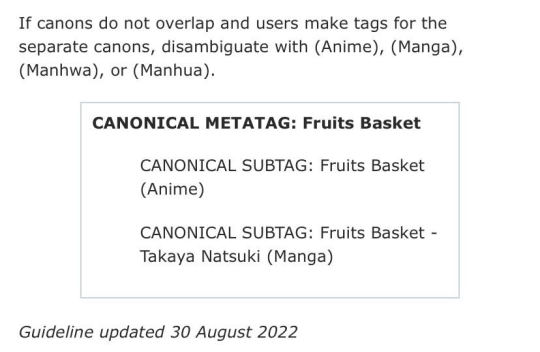
So, I guess the tag wrangler(s) for Fruits Basket consider the manga and the (unspecified which) anime to... not overlap? Or not overlap enough? Again, this confuses me. The 2019 anime covered all of canon and only had extremely minor changes, and those were mostly done just to make it work better in animation instead of print. The 2001 anime only covered the first third or so of the story and had some bigger changes, but nothing outside the realm of what a fan might change in a fanwork for the manga.
So, what do I think would be the best outcome for the Fruits Basket media tags on Ao3?
When I think about it, I could see people who had only seen the 2001 anime benefiting from being able to search only for works relating to the 2001 anime. And I could see people who have read the manga/seen the 2019 anime being annoyed if the major changes of the 2001 anime were referenced on works tagged to the manga/2019 anime. But I can't really see that happening between the manga and the 2019 anime. Those changes were so minute, I doubt they'd be relevant most of the time.
So, with the caveat that I'm only one user, and I don't know for sure if my opinion is the one held by most users in the Fruits Basket fandom, here are some potential solutions that would work for me & (I believe) for most users in the Fruits Basket fandom:
bring back "Fruits Basket" as a metatag for all 3 media types, or
make the manga tag synonymous with the 2019 anime, with the new canonical reading [Fruits Basket (Anime 2019 & Manga)], and make the 2001 anime a subtag of that new combined tag, or
make both anime tags subtags of the manga tag
Anyway, if you wanted to know what I've been doing instead of writing over the past few weeks, this is it. 😅 I'd really love to hear what you think of my proposed solutions, and if the change caused problems for you as it did for me, or if it actually made things easier.
Info about another tag wrangling issue for Fruits Basket coming soon in a separate (much shorter!) post!
#fruits basket#furuba#fruba#fanfic#ao3#poll#poll results#tumblr polls#my polls#canonical tags#metatags#ao3 tags#fandom tags#ao3 fandom#fanfic readers#fanfic authors#problem solving#tag wrangling#sort of#i am not a wrangler#but i'd like to be!#anime & manga#all media types#by cinderella-ish#my post
25 notes
·
View notes
Text

Analysis so bad you don't even know what it's talking about anymore.
#chrambles#not a lily orchard video (i have never watched one in my life im sorry for whoever did)#being a homestuck fan alone is hell. people make shit up and call it canon unironically its painful#can be of any form of analysis btw your responses are so insightful (and also funny)#if you mention dirkjohn in the tags then youre the one who needs to reread the canon material again lol
50K notes
·
View notes
Text


when there’s historical romance written abt ur friends
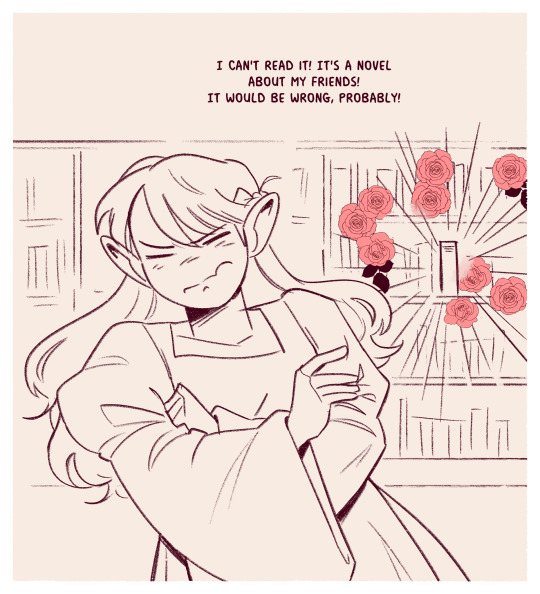
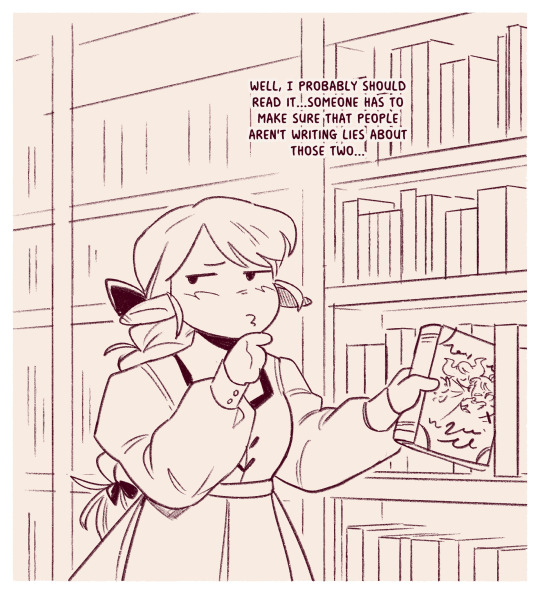
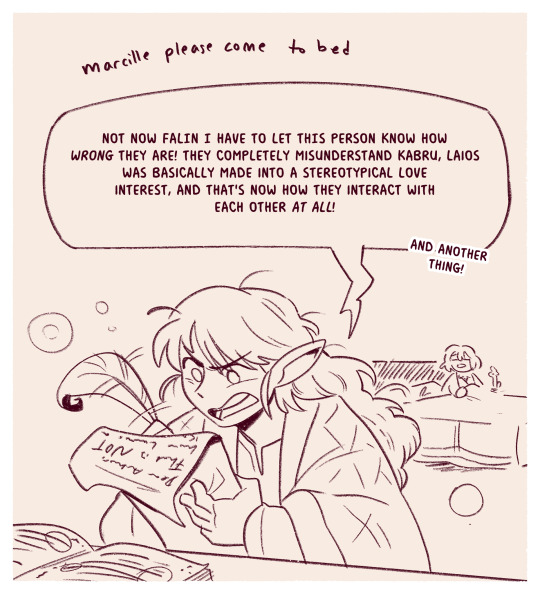
#dungeon meshi#marcille donato#falin touden#labru#not tagging the boys bc they’re not actually here lol#up to u how long this is after canon#dungeon meshi spoilers#orphe’s art
44K notes
·
View notes
Text



life lessons with grunkle ford
you can support my work on kofi!
#bill is not having a good time#gravity falls#stanford pines#mabel pines#dipper pines#the book of bill#billford#its canon in my au so im tagging it <3#doodle#book of bill spoilers#book of bill
48K notes
·
View notes
Text
Canonicalization: A Simple Guide on Canonical Tags
In today’s competitive online market, SEO is vital for businesses looking to thrive. Although search engines don’t disclose exactly how they rank websites, they offer valuable guidelines on improving rankings. One such guideline is canonicalization, a practice that plays a crucial role in preventing duplicate content issues.
When multiple URLs point to the same content, it can confuse search engines and impact rankings. Google recommends keeping URL structures simple to avoid this problem. A canonical tag directs search engines to the preferred version of a page, ensuring that key content is indexed while avoiding penalties for duplicate pages. By prioritizing important pages over duplicates, canonicalization becomes an essential part of a successful SEO strategy.
Let us take an example of a website that sells Mobile Phones which has different pages with the same content. Therefore, it might have different URLs for the same page such as
smartphone.com/apple smartphone.com/brand/apple smartphone.com/apple/utm_campaign All three pages have similar content or are exact replicas of each other. Such pages may be created due to some changes in the backend. These URLs could be used for tracking purposes or created due to different categories in the top navigation.
However, having so many URLs for the same page can leave Google incredibly confused about which URL to rank in the SERP.
(Depending on the signals, Google picks up one URL that it feels is the best version and ranks it.)
Google is not always accurate and might end up choosing the incorrect URL. This makes it necessary to let Google understand which page and URL to rank in the SERP and which to ignore. Here is where canonical tags come in the picture.
0 notes
Text
What are Canonical Tags?

Discover the importance of canonical tags in technical SEO and how they help prevent duplicate content issues, consolidate link equity, and improve user experience. This blog provides step-by-step guidance on implementing canonical tags, common mistakes to avoid, and their benefits for better indexing and ranking.
Want to boost your website’s performance? Read the full blog now!
0 notes
Text


just needed to map out his scars for science reasons, I promise...
#simon ghost riley#cod mw 19#call of duty#honestly for myself I'd make him even more ragged#but for canonical body I think that's it#mellounir art tag
14K notes
·
View notes
Text
How Canonical Tags are Beneficial for SEO

Canonical tags play a critical role in the optimization of your website for search engines. They can help your SEO efforts in the following ways:
What is a Canonical Tag?
A canonical tag is an HTML element that indicates the "preferred" version of a web page, helping webmasters avoid duplicate content problems.It tells search engines which version of a URL to index and rank.
Why Canonical Tags Matter
Avoid Duplicate Content Issues:
Unified Ranking: When multiple URLs contain similar or identical content, search engines may not know which one to rank. A canonical tag consolidates the ranking signals to the preferred URL.
Clean Index: It ensures that search engines do not index multiple versions of the same content, which can dilute the ranking potential.
Improved Crawl Efficiency:
Resource Management: By guiding search engines to the primary version of a page, canonical tags help them use their crawl budget more efficiently, focusing on unique content.
Consolidated Link Equity:
Link Juice: When different pages have inbound links, the canonical tag helps in combining the link equity to the canonical URL, enhancing its authority and ranking potential.
For more insights, explore our SEO services and Digital Marketing company
Implementing Canonical Tags
Identify Duplicate Content:
Audit Your Site: Use tools like Screaming Frog or Google Search Console to find duplicate content on your site.
Add Canonical Tags:
HTML Element: Include the canonical tag in the section of your HTML:htmlCopy code
Consistency:
Internal Linking: Ensure that internal links point to the canonical version of the page.
Sitemaps: Update your XML sitemaps to include only canonical URLs.
Common Issues and Solutions
Incorrect Canonical Tags:
Self-Referencing: Ensure that each page has a self-referencing canonical tag if it is the preferred version.
Avoid Loops: Do not create circular references between canonical tags.
Cross-Domain Canonical Tags:
Multiple Sites: Use cross-domain canonical tags to manage duplicate content across different domains effectively.
Dynamic Content:
Parameter Handling: For pages with URL parameters, use canonical tags to point to the clean version of the URL.
Best Practices
Use Absolute URLs:
Always use absolute URLs (including the protocol, domain, and path) in your canonical tags to avoid confusion.
Canonical Tag for Homepage:
Include a canonical tag on your homepage to specify the preferred version, especially if you have multiple variations (e.g., with/without ‘www’).
Monitor and Update:
Regularly check your site’s canonical tags for any errors or outdated links, especially after site changes or updates.
Benefits of Using Canonical Tags
Simplified SEO Management:
Focus on Primary Content: Canonical tags help search engines focus on the primary version of your content, simplifying your SEO efforts.
Reduced Server Load:
Efficient Crawling: By directing search engines to the preferred version of pages, you reduce unnecessary crawling, saving server resources.
Enhanced User Experience:
Consistent Content: Users are more likely to land on the correct version of your content, improving their overall experience on your site.
Conclusion
Canonical tags are essential for maintaining the integrity of your website’s SEO. They help manage duplicate content, improve crawl efficiency, consolidate link equity, and ensure a better user experience. By correctly implementing and maintaining canonical tags, you can significantly enhance your site's search engine performance. For more details, check out our SEO services and Digital Marketing company.
#search engine optimization#seo services#digital marketing#digital marketing services#canonical tags
1 note
·
View note
Text
Mastering Canonical Tags: Your Ultimate Guide to SEO Success
Learn how to properly implement and fix canonical tags to improve your website's SEO. Discover best practices, common mistakes, and expert tips to ensure your content is correctly indexed by search engines. Maximize your online visibility today! read our comprehensive guide and start optimizing your website today! https://myseoconsultants.uk/canonical-tag-how-to-fix-canonical-tags/
0 notes
Text

nothing personal but this kind of comment rlly exemplifies to me a disconnect between canon and popular fanon jmart characterization because they almost literally had this conversation in canon - except, their lines are swapped!


jon, for all his scared grouchiness, is a secret romantic, while martin, for all his forced optimism, is at his core a pragmatist
#and it's not like it's a throw away line either#its the penultimate episode and leads directly into the 'Where you go I go - that's the deal' convo#and this isnt the first time I've seen people swap them#otherwise i wouldn'tve made a whole post#tma#tma s5#tma finale#jonmartin#tma meta#stole the screenshot from another post because i didnt want to derail what people are mostly reblogging for a cute moment#and y know. it IS cute. that's why it's so weird that people seem to forget how it's nearly literally canon#EDIT: added that tag to the body of the post cause its rlly the conclusion
9K notes
·
View notes
Text



don't think I'm not still obsessing over 7-12
#art#twisted wonderland#twisted wonderland spoilers#twisted wonderland episode 7 spoilers#twisted wonderland book 7 spoilers#twisted wonderland episode 7 part 12 spoilers#twisted wonderland book 7 part 12 spoilers#sorry it's even scribblier than usual :') hopefully my chickenscratch is legible#anyway come here and join me in the corner where we go to be embarrassing about anime characters#just. between riddle and trey's dreams i've been thinking a lot about how#trey knew this kid for like two months when he was nine and then never really got over him or how their friendship ended#which. honestly. understandable given the circumstances#and then when they finally met again riddle acted like they'd never met before and neither he nor trey ever intended trey to be his vice#but every time riddle talks about his childhood post-incident it's basically#'oh yeah i constantly thought about trey and che'nya and fantasized about still being friends with them! this is fine and normal'#(there's a bit in one of his birthday cards where he talks about crossword puzzles and shit man that one got me)#idk. i can't put this into words very well#just...the implications that riddle was actively resisting trey's friendship#(presumably because it ended SUPER badly last time and he's learned that if he shows he wants something it gets taken away from him)#and trey had to work REALLY hard to just to get to the point they were at by the time canon starts#that was progress somehow#y'all can call him boring all you want but trey's defining feature really is that he keeps being like#'everything's fine :) this isn't a big deal :) i don't care that much'#(trey on the inside: THIS IS THE BIGGEST DEAL THAT I CARE SO MUCH ABOUT AND I WILL NEVER LET IT GO)#anyway i continue to be absolutely murdered by the timing of riddlepunzel directly after this#riddle's line about not wanting to keep standing in front of a door that's never going to open...#hey. hey silly gacha game about anime disney boys.#you are not actually allowed to do this to me#oh shit oh damn i'm out of tags and i haven't even talked about cater yet. NO BUT I HAVE LOTS OF FEELINGS THERE TOO --#(i am crushed under a falling safe looney tunes style)
5K notes
·
View notes
Text
"Your boyfriend is evil!" "Your boyfriend is cruel and horrifying!" Well, he's a joy to me. Maybe it's a you problem.
#self ship#self shipping#f/o: hades#f/o tag: soulbound#oc x canon#evil f/o#villain f/o#blorbo posting
29K notes
·
View notes
Text

Baby, both arms cradle you now
#he’s alive dw Jayce is just dramatic#dramatic meaning traumatized#and can’t lose Viktor again#jayvik#arcane#arcane art#viktor arcane#arcane spoilers#viktor#jayce talis#viktor x jayce#jayce x viktor#jayce fanart#viktor season 2#viktor fanart#arcane au#arcane post canon#post canon jayvik#Jayvik au#art tag#my art
3K notes
·
View notes
Text
You are dropped in a Star Trek location. Spin this wheel to find out which location and this wheel to find out who you are with.
#Yes Abraham Lincoln is a canon Star Trek character of course he is on the wheel#If you want to spin until you get a character you know I am not going to stop you#it has been fun reading the tags and seeing everyone excited to hang out with their blorbos
4K notes
·
View notes
Text


THE IMPLICATIONS ARE ASTONISHING
#CANONICALLY POKE-ABLE#doodle tag#twst#twisted wonderland#kalim al asim#twst silver#silkali#<- not technically ship but i believe The Council should see this
5K notes
·
View notes
Text




normally i don't draw my anthropomorphized characters with boobs but tonight they get a special treat
6K notes
·
View notes